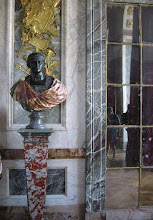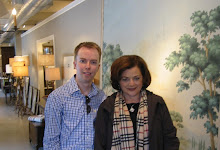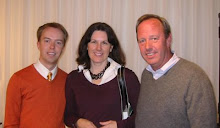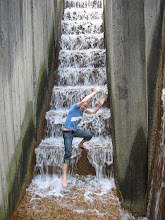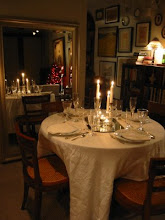
Located on top of the 'Mound', the Casino provides a focal point to the view from the house as well as provide the typical garden folly; a place to enjoy the view of the gardens and the house.

Located in a heavily wooded garden on the map(#12), the Casino (#13) overlooks what would have been the original water park behind the estate, which was sold in the 1940s to the Catholic Diocese who developed the site.

The structure is part of the retaining wall system of the mound and is 1 story facing the garden and main house and 2 stories on the rear. It should be noted that the trees were planted full growth so as to provide instant shade!

I loved these garden benches in front of the 2 rooms of the Casino.

Salvaged marble composite capitals decorate the steps up to the loggia of the Casino.

The ceiling of the loggia is painted in the Italian Renaissance style.

The center panel (painted by Paul Thevanez) was infilled into an older found painting from the studio of none other than Gianbattista Tiepolo.

You can see where it has been pieced together and also (I believe) a recent and ongoing restoration.

The interiors of the 2 rooms flanking the loggia are decorated in 18th century italian style.

Grand chandeliers for the smallest of rooms and don't forget the fireplaces!

Imagine taking tea here in the gardens; I would never leave!

Notice the patterned marble floors.

Each room is slightly different, but each is furnished with a seating area in front of a fireplace.

The painted finish on the interior is really gorgeous.

On the sides of the Casino are these statues decorating the front of where the chimneys are hidden.

The views down to the rear garden lawn are now lush and green, although back in Deering's time they faced acres of canals where guests could ride gondolas; sort of a private amusement park or ultra-chic lazy river!

The canals were infilled for development and a screen of trees was planted, changing the view forever.

The steps snake down the sides of the casino and down to what would have been a gondola launch.

The underside of the casino had restrooms flanking a loggia, similar to upstairs, which are now mechanical rooms. I loved these little round windows looking into these rooms below.

The little Casino doesn't look so small from behind!

The photoshoot seemed to be following me around the gardens.

Notice the delicate ironwork.

The rusticated coral limestone is really spectacular at this lower level.

The lower loggia has fountains in line with the openings and a barrel vaulted ceiling.

The overdoors to the entry to the bathrooms have these great faces!

It's not Italianaite without some statuary!

The launch for the long-gone gondolas still exists, albeit it a little overgrown.

A charming reminder of what once was.
 Last week, in my post on Vizcaya's bayside facade, I mentioned the pool which ingeniusly slips into the house for access and shelter.
Last week, in my post on Vizcaya's bayside facade, I mentioned the pool which ingeniusly slips into the house for access and shelter. The Swan was kind enough to remind us that the pool's grotto has a ceiling which was painted by the artist Robert Winthrop Chanler.
The Swan was kind enough to remind us that the pool's grotto has a ceiling which was painted by the artist Robert Winthrop Chanler. Chanler, like others involved with the project, received his education at the Ecole des Beaux-Arts in Paris. Deering hired him to work on an 'under sea' fantasy fresco to decorate the interior of the pool grotto.
Chanler, like others involved with the project, received his education at the Ecole des Beaux-Arts in Paris. Deering hired him to work on an 'under sea' fantasy fresco to decorate the interior of the pool grotto. The exterior access to the pool is via flanking coral limestone staircases that matches the rest of the house's stone.
The exterior access to the pool is via flanking coral limestone staircases that matches the rest of the house's stone. Interior access to the pool was via the lower level through 2 sets of french stained glass doors. These doors are adjacent to held Deering's smoking room (soon to be a giftshop) as well as a bowling alley (soon to be cafe)!
Interior access to the pool was via the lower level through 2 sets of french stained glass doors. These doors are adjacent to held Deering's smoking room (soon to be a giftshop) as well as a bowling alley (soon to be cafe)! The ceiling was first sculpted of Gesso and painted while still wet to result in the fresco we see today. The floors are marble and echo others seen throughout the house. Notice the lovely bronze guardrails.
The ceiling was first sculpted of Gesso and painted while still wet to result in the fresco we see today. The floors are marble and echo others seen throughout the house. Notice the lovely bronze guardrails. Moulded seashells and other sea life decorate the scenes.
Moulded seashells and other sea life decorate the scenes. The painting has not weathered the humidity nor the occasional hurricane damage well but the effect is still lovely. Imagine how lucky Deering's guests felt to be taking a dip here!
The painting has not weathered the humidity nor the occasional hurricane damage well but the effect is still lovely. Imagine how lucky Deering's guests felt to be taking a dip here!
 Located on top of the 'Mound', the Casino provides a focal point to the view from the house as well as provide the typical garden folly; a place to enjoy the view of the gardens and the house.
Located on top of the 'Mound', the Casino provides a focal point to the view from the house as well as provide the typical garden folly; a place to enjoy the view of the gardens and the house.
 The structure is part of the retaining wall system of the mound and is 1 story facing the garden and main house and 2 stories on the rear. It should be noted that the trees were planted full growth so as to provide instant shade!
The structure is part of the retaining wall system of the mound and is 1 story facing the garden and main house and 2 stories on the rear. It should be noted that the trees were planted full growth so as to provide instant shade! I loved these garden benches in front of the 2 rooms of the Casino.
I loved these garden benches in front of the 2 rooms of the Casino. Salvaged marble composite capitals decorate the steps up to the loggia of the Casino.
Salvaged marble composite capitals decorate the steps up to the loggia of the Casino. The ceiling of the loggia is painted in the Italian Renaissance style.
The ceiling of the loggia is painted in the Italian Renaissance style.  The center panel (painted by Paul Thevanez) was infilled into an older found painting from the studio of none other than Gianbattista Tiepolo.
The center panel (painted by Paul Thevanez) was infilled into an older found painting from the studio of none other than Gianbattista Tiepolo. You can see where it has been pieced together and also (I believe) a recent and ongoing restoration.
You can see where it has been pieced together and also (I believe) a recent and ongoing restoration. The interiors of the 2 rooms flanking the loggia are decorated in 18th century italian style.
The interiors of the 2 rooms flanking the loggia are decorated in 18th century italian style. Grand chandeliers for the smallest of rooms and don't forget the fireplaces!
Grand chandeliers for the smallest of rooms and don't forget the fireplaces! Imagine taking tea here in the gardens; I would never leave!
Imagine taking tea here in the gardens; I would never leave! Notice the patterned marble floors.
Notice the patterned marble floors. Each room is slightly different, but each is furnished with a seating area in front of a fireplace.
Each room is slightly different, but each is furnished with a seating area in front of a fireplace. The painted finish on the interior is really gorgeous.
The painted finish on the interior is really gorgeous. On the sides of the Casino are these statues decorating the front of where the chimneys are hidden.
On the sides of the Casino are these statues decorating the front of where the chimneys are hidden. The views down to the rear garden lawn are now lush and green, although back in Deering's time they faced acres of canals where guests could ride gondolas; sort of a private amusement park or ultra-chic lazy river!
The views down to the rear garden lawn are now lush and green, although back in Deering's time they faced acres of canals where guests could ride gondolas; sort of a private amusement park or ultra-chic lazy river! The canals were infilled for development and a screen of trees was planted, changing the view forever.
The canals were infilled for development and a screen of trees was planted, changing the view forever. The steps snake down the sides of the casino and down to what would have been a gondola launch.
The steps snake down the sides of the casino and down to what would have been a gondola launch. The underside of the casino had restrooms flanking a loggia, similar to upstairs, which are now mechanical rooms. I loved these little round windows looking into these rooms below.
The underside of the casino had restrooms flanking a loggia, similar to upstairs, which are now mechanical rooms. I loved these little round windows looking into these rooms below. The little Casino doesn't look so small from behind!
The little Casino doesn't look so small from behind! The photoshoot seemed to be following me around the gardens.
The photoshoot seemed to be following me around the gardens. Notice the delicate ironwork.
Notice the delicate ironwork. The rusticated coral limestone is really spectacular at this lower level.
The rusticated coral limestone is really spectacular at this lower level. The lower loggia has fountains in line with the openings and a barrel vaulted ceiling.
The lower loggia has fountains in line with the openings and a barrel vaulted ceiling. The overdoors to the entry to the bathrooms have these great faces!
The overdoors to the entry to the bathrooms have these great faces! It's not Italianaite without some statuary!
It's not Italianaite without some statuary! The launch for the long-gone gondolas still exists, albeit it a little overgrown.
The launch for the long-gone gondolas still exists, albeit it a little overgrown.  A charming reminder of what once was.
A charming reminder of what once was.
 The main facade of Vizcaya is really the 'back', facing Biscayne Bay. The first time Deering ever saw his completed winter house was actually arriving by boat.
The main facade of Vizcaya is really the 'back', facing Biscayne Bay. The first time Deering ever saw his completed winter house was actually arriving by boat.
 This construction photo shows the first floor as well as gives you an idea of what the house looked like when the center was an entirely open courtyard. You can see right through the house to the
This construction photo shows the first floor as well as gives you an idea of what the house looked like when the center was an entirely open courtyard. You can see right through the house to the  The terrace steps right down to the water. Deering actually chose the location for the house, unusually close to the water, against the advice of the design team members. This relationship is so important in person that it was an ingenius decision.
The terrace steps right down to the water. Deering actually chose the location for the house, unusually close to the water, against the advice of the design team members. This relationship is so important in person that it was an ingenius decision. Just to the right is the tea house, built prominently out into the bay.
Just to the right is the tea house, built prominently out into the bay. Probably the most charming space on the entire estate, I can see breakfasts and afternoon tea being served here. Besides the view back at the house seen below, an excellent view of downtown Miami is also visible.
Probably the most charming space on the entire estate, I can see breakfasts and afternoon tea being served here. Besides the view back at the house seen below, an excellent view of downtown Miami is also visible. The use of interior trellis was big at the time, popularized by Elsie de Wolfe, who had recommended Paul Chalfin to assist Deering.
The use of interior trellis was big at the time, popularized by Elsie de Wolfe, who had recommended Paul Chalfin to assist Deering.
 The most well known aspect of the garden is probably the stone barge, built out in the bay from the terrace.
The most well known aspect of the garden is probably the stone barge, built out in the bay from the terrace. Originally, the barge was heavily planted, covered with statues and had a small pavilion as well.
Originally, the barge was heavily planted, covered with statues and had a small pavilion as well.  This design obviously doesn't weather hurricane season very well and is a bit high maintenance for a house museum! Below you see the barge in 1934, a simplified version after the 1926 hurricane.
This design obviously doesn't weather hurricane season very well and is a bit high maintenance for a house museum! Below you see the barge in 1934, a simplified version after the 1926 hurricane. Just around the corner from the terrace was the swimming pool.
Just around the corner from the terrace was the swimming pool. The swimming pool, in Roman fashion, is submerged half into the house and half in the open air, so that entry can be gained without going outside in your bathing costume (this was prior to the bikini being the official dress code of Miami).
The swimming pool, in Roman fashion, is submerged half into the house and half in the open air, so that entry can be gained without going outside in your bathing costume (this was prior to the bikini being the official dress code of Miami). 






















.jpg)






















.JPG)



























































